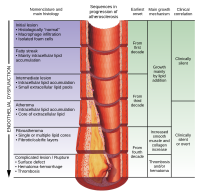
Photo from wikipedia
Coronary artery aneurysms are defined as an abnormal dilatation of the coronary artery lumen of more than 1.5 times compared with the normal adjacent segments. In case of diffuse dilatation… Click to show full abstract
Coronary artery aneurysms are defined as an abnormal dilatation of the coronary artery lumen of more than 1.5 times compared with the normal adjacent segments. In case of diffuse dilatation affecting the entire length of a coronary vessel, the term coronary artery ectasia is used, whereas the term coronary aneurysm is used for short and focal dilatation of coronary artery segments [1]. The estimated prevalence of coronary aneurysms is between 1.2 and 7.4%, and is observed predominantly in male patients [1]. Atherosclerosis appears to be the underlying cause of developing aneurysms in the coronary arteries in adults, whereas inflammatory diseases, especially Kawasaki disease, can lead to the development of coronary aneurysms in the young population [1,2].
Journal Title: Coronary Artery Disease
Year Published: 2017
Link to full text (if available)
Share on Social Media: Sign Up to like & get
recommendations!